Monthly Archives: May 2012
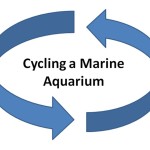
Cycling a Marine Aquarium
I just thought I would take some time to explain some of the methods that can be used to cycle a marine aquarium in a little more detail that what we currently have on our forum. The nitrogen cycle in a marine environment is similar to that of the nitrogen cycle in a fresh water environment. In both environments you have nitrifying bacteria that coverts ammonia into nitrites and nitrites into nitrates. While the nitrifying bacteria in a marine aquarium are different bacteria then the nitrifying bacteria in a fresh water tank, they do perform the same functions and essentially work the same. A marine nitrogen cycle has the addition of de nitrifying bacteria which converts nitrates into nitrogen gas. I will be making many comparisons between the fresh water and salt water cycling methods through this article in order to better illustrate some points better for people who are new to salt water aquariums.
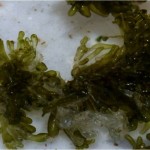
Dealing with Nasty Marine Algae Break-outs
This article is about the nasty marine algae that can plague some people to the point of wanting to get out of the hobby. The good news here is that once you learn more about what most algae need, you can control them and prevent them from becoming a problem again. This doesn’t include any information about macro algae. Having a little bit of agae in you tank is not a bad thing, and (in my opinion) can give your aquarium a more natural look and feel. When the algae gets out of control is when we need to take steps to control it.
There is a common belief that a new tank will go through various stages of different nuisance marine algae as the tank cycles and then matures over the next 6 months to a year. In my opinion and experience, that is not completely accurate. Although there will likely be some small swings in some parameters as the tank matures, you don’t have to go through any excessive algae stages by properly planning your set-up and applying some preventative measures from the start. Some algae here and there is normal, but a lot of it is not. I will share some of my experiences (both the good and the bad) at the end of this article.
Some History Behind the Hobby
This is topic is one that has always interested me so I thought it would be a fun topic to post here. The below is based in a lot of different books and articles that I have read over the past few years. It’s more of a collection of some of the important milestones that played a big part in developing into the hobby we all enjoy today. I hope I have remembered all of the dates correctly, so here goes…….
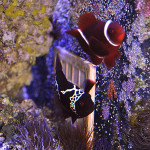
The lightning maroon clownfish finally spawned!!!
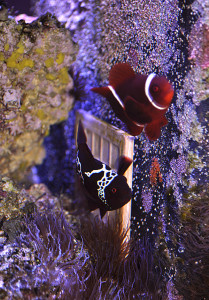
By: Matt Pedersen
Yes you read right. Matt Pedersen little “doubling down“ trick to get them to spawn that we wrote about here seems to have worked and the lightning maroon clownfish has finally spawned after 2 years of trying. This is very good news for all those who hope to keep these stunning fish one day, myself included.
Matt has been trying to get them to breed for two years now pairing it with a number of other maroon clownfish of both sexes. Finally it paired with a smaller maroon clownfish and this morning matt could finally report that they had spawned for the first time. (read the full story here.) It is a bit early to get too excited since it is common for the first spawns to fail and to produce where few fertile eggs but once a clownfish pair start to spawn they usually continue doing so. Matt should hopefully soon have a number of lightning clowns to breed from and pass on to other successfully breeders so that they can help this clown fish become more available. This clownfish really deserves to become a common sight in aquariums around the worlds and the chances of that happening greatly increased today.
Until today only two lightning maroon clownfish was ever caught, both in the waters of Papua New Guinea. Just a few weeks ago a third fish was caught in the same waters that resembles the lightning maroons but with a much less distinct pattern. See the image below. This latest catch was aquired by EcoReef UK
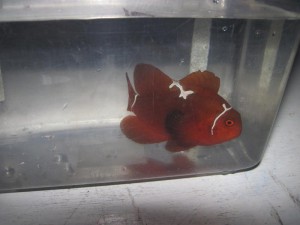
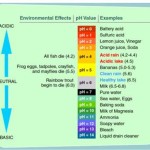
pH in Marine Aquariums
pH (Potential Hydrogen) is simply a way to measure the concentration of hydrogen ions in solution. With a PH of 7.0, water is said to be neutral, anything lower becomes acidic while anything higher is said to become alkaline (basic). The scale used to measure pH is also logarithmic due to the enormous range of hydrogen ions. Using this type of scale, you will see a increase in hydrogen ions by a factor of 10 for each 1.0 difference in the pH values. For example, when you have a PH of 6 there is 10 times as many hydrogen ions as compared to a pH of 7 and 100 times as many ions as compared to a pH of 8.0. This is a good way to illustrate the potential scope of the impact a change in pH can have.
Generally, a pH of 7.9 to 8.4 is considered to be the normal range for a average marine aquarium. I always like to keep my pH stable at a value between 8.0 and 8.3. pH is a very important element of water chemistry to understand and test for, as large and quick swings in your pH can cause stress to fish and corals even resulting in deaths in certain situations. pH is one of the aspects of water quality that can also be an indicator or symptom that something else may be off in your set-up. For that reason I do not recommended trying to adjust your pH with pH stabilizing or adjusting chemicals as you may not be fixing the potential problem(s) but only masking the symptoms. If you are having difficulty maintaining your pH, you should first try to understand the cause of the pH problems and address those causes first. That approach has always worked best for me.
The two biggest factors that commonly affect your pH are:
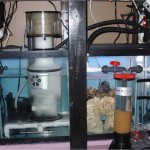
Some Sump Basics
Simply worded, a sump is just a secondary tank that is set-up and linked into a main / display tank as an option for placing equipment as well as providing filtration for the main tank.
If I have learned anything in this hobby it is that there are many many different ways to achieve a healthy and thriving tank. This could not be any truer with how you choose to set up a sump. Likely the best way to approach this topic is to describe the factors that I learned which go into designing your sump and then show you how I set up my sump just as one example. I hope you will find these sump basics helpful.